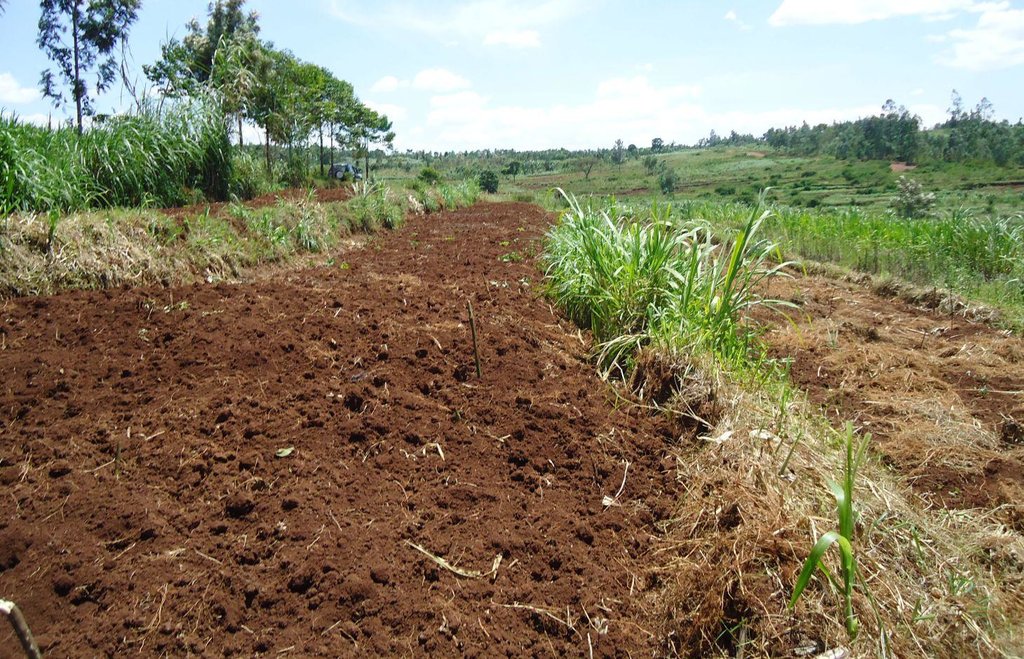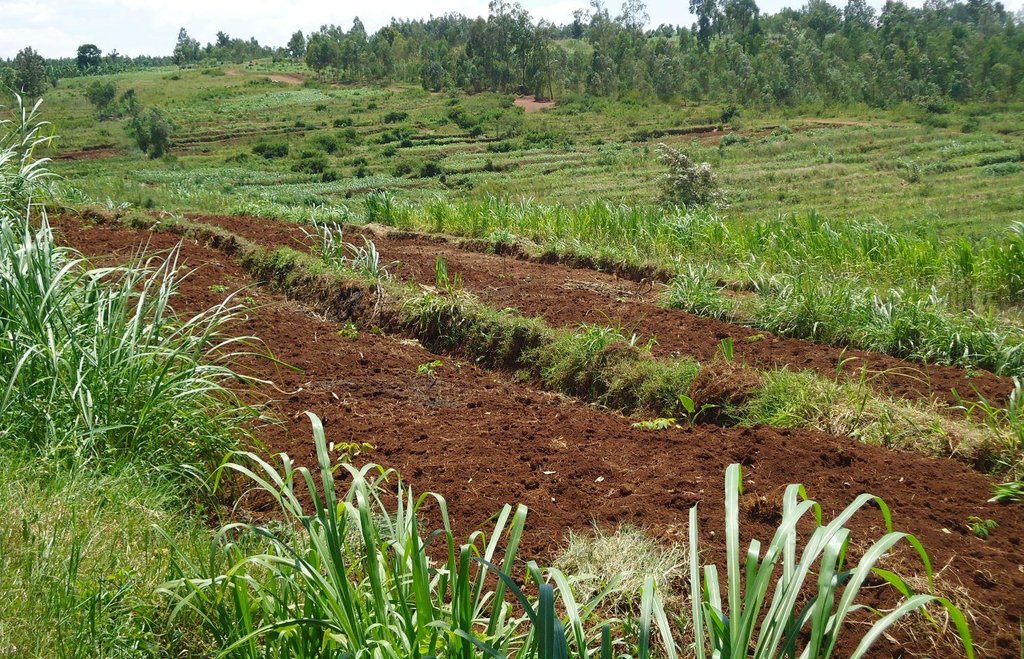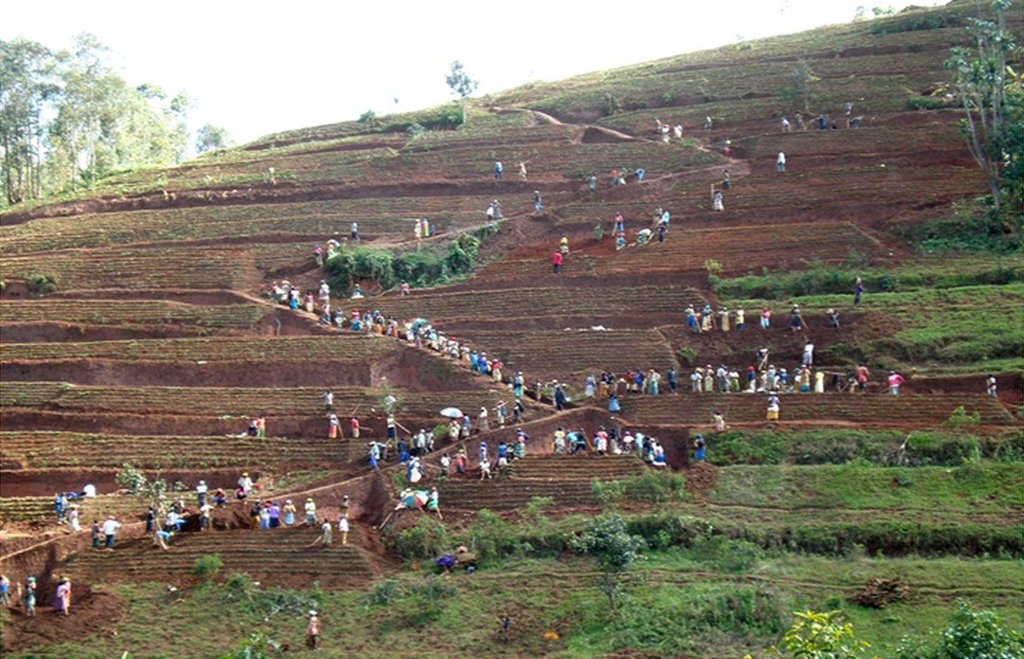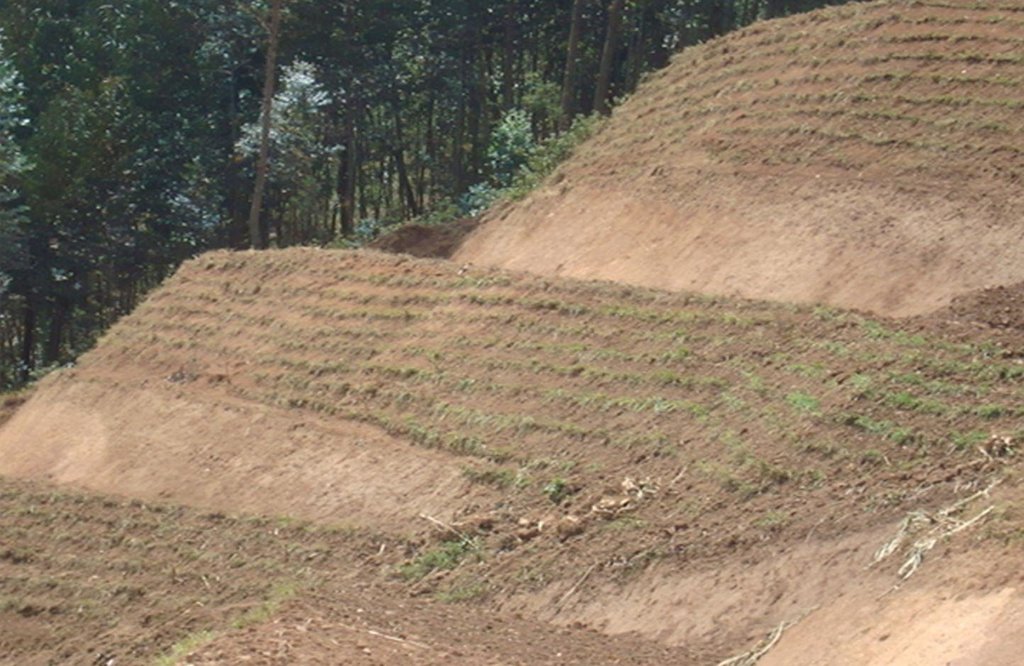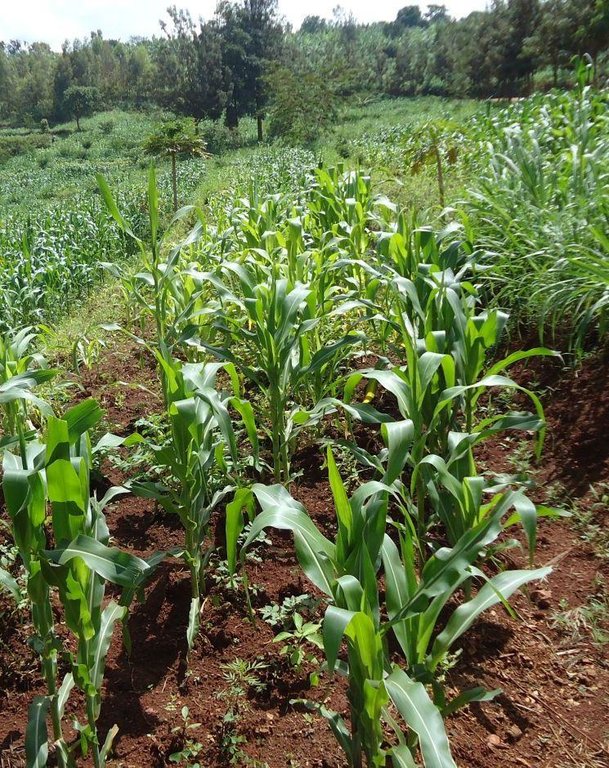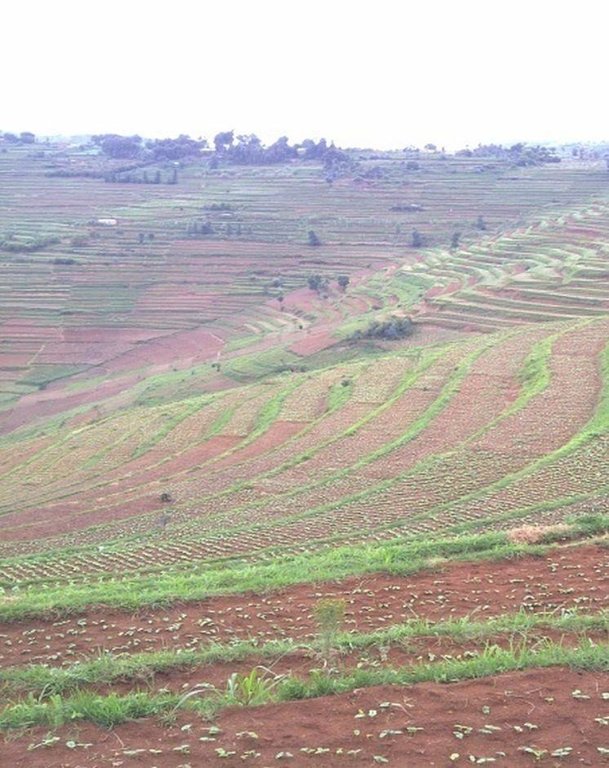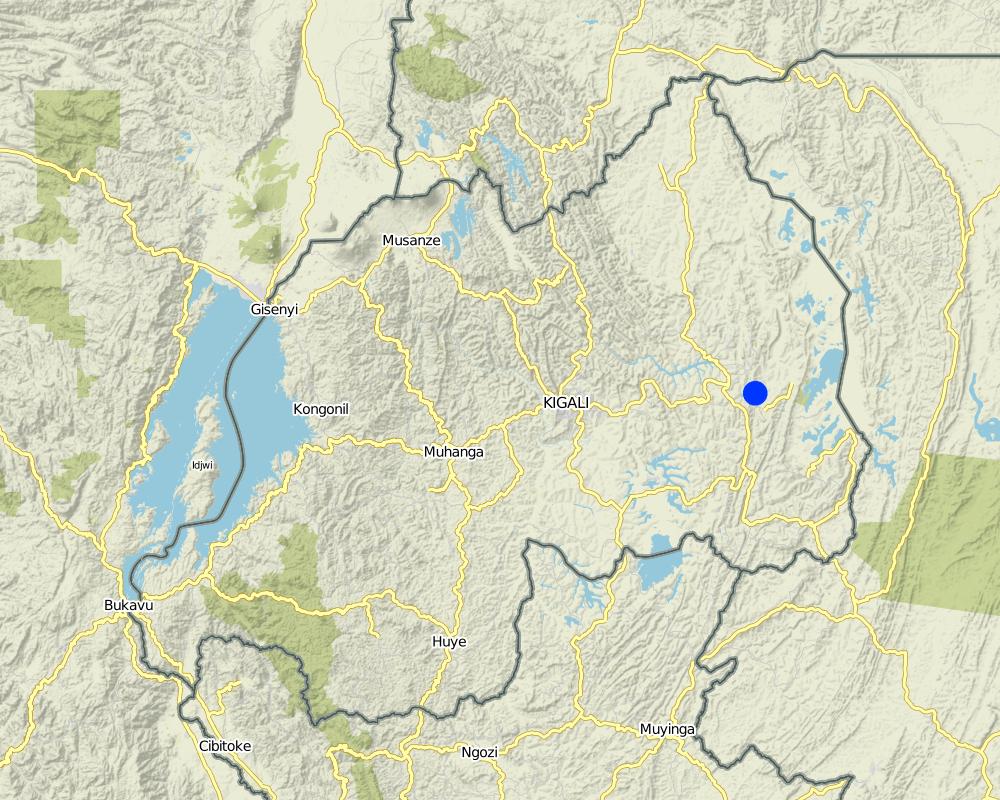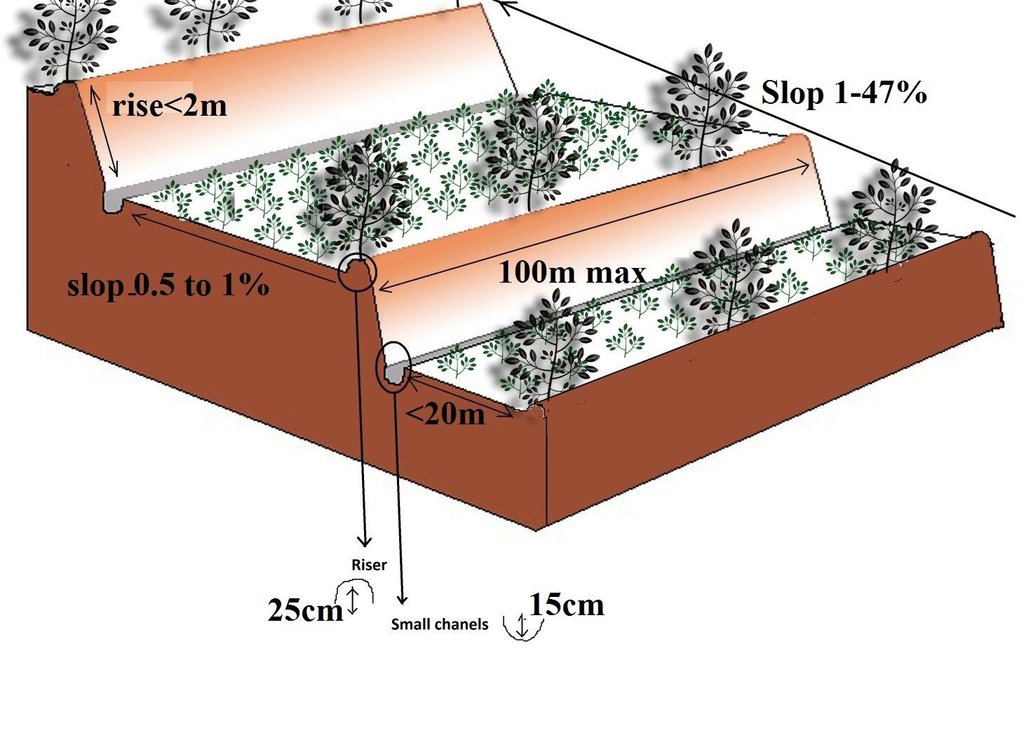Radical Terraces [Rwanda]
- Creation:
- Update:
- Compiler: Desire Kagabo
- Editor: –
- Reviewer: David Streiff
Amaterasi y'indinganire
technologies_1553 - Rwanda
View sections
Expand all Collapse all1. General information
1.2 Contact details of resource persons and institutions involved in the assessment and documentation of the Technology
SLM specialist:
SLM specialist:
Name of project which facilitated the documentation/ evaluation of the Technology (if relevant)
The Transboundary Agro-ecosystem Management Project for the Kagera River Basin (GEF-FAO / Kagera TAMP )Name of the institution(s) which facilitated the documentation/ evaluation of the Technology (if relevant)
Food and Agriculture Organization of the United Nations (FAO) - ItalyName of the institution(s) which facilitated the documentation/ evaluation of the Technology (if relevant)
Rwanda Agriculture Board (Rwanda Agriculture Board) - Rwanda1.3 Conditions regarding the use of data documented through WOCAT
The compiler and key resource person(s) accept the conditions regarding the use of data documented through WOCAT:
Ja
2. Description of the SLM Technology
2.1 Short description of the Technology
Definition of the Technology:
Locally referred to as ‘radical terracing’, the method involves earth moving operations that create reverse-slope bench terraces which have properly shaped risers stabilized with grass or trees on embankment to avoid collapse.
2.2 Detailed description of the Technology
Description:
In Rwanda, a unique method of back-slope terracing originally introduced by missionaries growing wheat in the Northern Province in the 1970s, has been widely adopted by smallholder farmers in many parts of the country. The farmers are careful to isolate the topsoil, then they re-work the subsoil to create the required reverse-slope bench, after which the topsoil is spread over the surface. The riser is planted with short runner grass for stabilization, all within the same day. Radical terracing is usually done manually with hoes and shovels, mostly by communal group-work involving hundreds of farmers (see left photo). Thus, a hillside can be terraced in one day. Where radical terraces have been constructed, the effects have been dramatic, achieving optimum water and soil conservation on slopes exceeding 50%, while adoption rates have been quite extensive. This high adoption of radical terracing is related to the existing policies and programs such as land consolidation, land management and crop intensification programs. These policies/programs boost the use of radical terraces by providing farmers more opportunities to easily access inputs such as improved seeds and manure for increasing the productivity of constructed radical terraces. Recent studies (e.g. Fleskens, 2007, Bizoza and de Graaff 2012 and Kagabo et al. 2013) assert that radical terraces in the highlands of Rwanda are only financially viable when the opportunity cost of labour and manure are below the local market price levels and when agriculture area on these radical terraces can be substantially intensified. Ten to 30 metric tons of manure (organic) are required to restore the soil fertility of newly established radical terraces.
Purpose of the Technology: In Rwanda, radical terraces are principally designed (1) to reduce soil losses through enhanced retention and infiltration of runoff, (2) to promote permanent agriculture on steep slopes and (3) to promote land consolidation and intensive land use.
Establishment / maintenance activities and inputs: Newly established radical terraces should be protected at their risers and outlets, especially in the first or second year of the establishment. After establishing a terrace, a riser is shaped and grasses or shrubs/trees are planted soon after. Napier grass is commonly planted and is used as forage for livestock. Risers on radical terraces are seen as a new production niche of forage as a result of land shortage and a strict zero grazing policy.
Natural / human environment: Radical terraces have the potential of improving farmers’ livelihoods and increasing the resilience of a degraded environment.
2.3 Photos of the Technology
2.5 Country/ region/ locations where the Technology has been applied and which are covered by this assessment
Country:
Rwanda
Region/ State/ Province:
Rwanda
Further specification of location:
Kayonza District (Eastern province)
Map
×2.6 Date of implementation
If precise year is not known, indicate approximate date:
- less than 10 years ago (recently)
2.7 Introduction of the Technology
- Government
Comments (type of project, etc.):
The Government introduced it through local leaders and agronomist. It was established in 2004
3. Classification of the SLM Technology
3.1 Main purpose(s) of the Technology
- reduce, prevent, restore land degradation
3.2 Current land use type(s) where the Technology is applied

Cropland
- Annual cropping
- Perennial (non-woody) cropping
Main crops (cash and food crops):
major cash crop: Sweet potato and pineapple
Comments:
Major land use problems (compiler’s opinion): Soil erosion due to high runoff on the steep slopes, deforestation, intensive cultivation and lack of suitable land management methods.
Major land use problems (land users’ perception): Low crop production, soil erosion and lack of fodder
3.3 Further information about land use
Water supply for the land on which the Technology is applied:
- rainfed
Number of growing seasons per year:
- 2
Specify:
Longest growing period in days: 120; Longest growing period from month to month: September- January; Second longest growing period in days: 90; Second longest growing period from month to month: March - June
3.4 SLM group to which the Technology belongs
- cross-slope measure
3.5 Spread of the Technology
Specify the spread of the Technology:
- evenly spread over an area
Comments:
Total area covered by the SLM Technology is 10.3 km2.
3.6 SLM measures comprising the Technology

vegetative measures
- V2: Grasses and perennial herbaceous plants

structural measures
- S1: Terraces
Comments:
Type of vegetative measures: aligned: -contour
3.7 Main types of land degradation addressed by the Technology

soil erosion by water
- Wt: loss of topsoil/ surface erosion
- Wo: offsite degradation effects
Comments:
Secondary types of degradation addressed: Wo: offsite degradation effects
Main causes of degradation: over-exploitation of vegetation for domestic use, overgrazing (Grazing and fodder), other natural causes (avalanches, volcanic eruptions, mud flows, highly susceptible natural resources, extreme topography, etc.) specify (Extreme topography: steep slopes in many cases over 50%), population pressure (High density (in rural area over 400 inhabitant per ha))
Secondary causes of degradation: deforestation / removal of natural vegetation (incl. forest fires) (Use of cooking energy (fire wood)), poverty / wealth (Farmers have low income and have less access to off farm income or remittances), education, access to knowledge and support services (High rate of irriteracy)
3.8 Prevention, reduction, or restoration of land degradation
Specify the goal of the Technology with regard to land degradation:
- reduce land degradation
Comments:
Secondary goals: prevention of land degradation, rehabilitation / reclamation of denuded land
4. Technical specifications, implementation activities, inputs, and costs
4.1 Technical drawing of the Technology
4.2 Technical specifications/ explanations of technical drawing
The farmers are careful to isolate the topsoil, then they re-work the subsoil to create the required reverse-slope bench, after which the topsoil is spread over the surface. The riser is planted with short runner grass for stabilization, all within the same period.
Location: Nyamirama. Kayonza/West/Rwanda
Date: 2013
Technical knowledge required for field staff / advisors: high (Special training should be provided to field staff to be able to make an adequate design)
Technical knowledge required for land users: moderate (Land users are required to only implement the technology under the supervision of field staff)
Main technical functions: control of concentrated runoff: retain / trap
Secondary technical functions: control of concentrated runoff: impede / retard, reduction of slope angle, reduction of slope length, increase of infiltration
Aligned: -contour
Vegetative material: G : grass
Number of plants per (ha): 2000
Vertical interval between rows / strips / blocks (m): 1
Spacing between rows / strips / blocks (m): 4
Vertical interval within rows / strips / blocks (m): 0.2
Width within rows / strips / blocks (m): 0.2
Grass species: Pennisetum
Slope (which determines the spacing indicated above): 35%
If the original slope has changed as a result of the Technology, the slope today is (see figure below): 0%
Gradient along the rows / strips: 0%
Terrace: bench level
Vertical interval between structures (m): 2
Spacing between structures (m): 4
Slope (which determines the spacing indicated above): 20-50%
If the original slope has changed as a result of the Technology, the slope today is: 0%
Lateral gradient along the structure: 0%
Vegetation is used for stabilisation of structures.
4.3 General information regarding the calculation of inputs and costs
other/ national currency (specify):
Rwandan francs
Indicate exchange rate from USD to local currency (if relevant): 1 USD =:
640.0
Indicate average wage cost of hired labour per day:
1000
4.4 Establishment activities
| Activity | Type of measure | Timing | |
|---|---|---|---|
| 1. | Cuttings of grasses | Vegetative | Rain season |
| 2. | Transport of grass cuttings | Vegetative | Rain season |
| 3. | Planting of grass cuttings | Vegetative | Rain season |
| 4. | Land surveying (slope determination, soil structure and texture analysis) | Structural | any time |
| 5. | Construction of bunds (risers) with soil from upper and lower sides | Structural | dry season |
| 6. | Level terraces bed (surface soil moved from upper to lower part of terraces) | Structural | dry season |
| 7. | cutting subsurface soil, leveling and refilling surface soil | Structural | dry season |
| 8. | Make lips on edges of terraces | Structural | dry season |
| 9. | Compact risers | Structural | dry season |
| 10. | Plant grasses including agro-forestery trees. | Structural | rainy season |
| 11. | Input/ application of farmyard manure and liming | Structural | rainy season |
4.5 Costs and inputs needed for establishment
| Specify input | Unit | Quantity | Costs per Unit | Total costs per input | % of costs borne by land users | |
|---|---|---|---|---|---|---|
| Labour | Cuttings of grasses | persons/day/ha | 2.0 | 1000.0 | 2000.0 | 60.0 |
| Labour | Transport of grass cuttings | persons/day/ha | 10.0 | 1000.0 | 10000.0 | |
| Labour | Planting of grass cuttings | persons/day/ha | 20.0 | 1000.0 | 20000.0 | 100.0 |
| Labour | Land surveying (slope determination, soil structure and texture | persons/day/ha | 6.0 | 20000.0 | 120000.0 | |
| Fertilizers and biocides | Lime | kg/ha | 2500.0 | 40.0 | 100000.0 | |
| Fertilizers and biocides | Famyard manure | kg/ha | 30000.0 | 5.0 | 150000.0 | |
| Fertilizers and biocides | Mineral fertilizers | kg/ha | 300.0 | 500.0 | 150000.0 | |
| Other | Labour: Construction of bunds | persons/day/ha | 100.0 | 1000.0 | 100000.0 | |
| Other | Labour: Level terraces bed | persons/day/ha | 250.0 | 1000.0 | 250000.0 | |
| Other | Labour: Cutting subsurface soil | persons/day/ha | 250.0 | 1000.0 | 250000.0 | |
| Other | Labour: Make lips on edges of terraces | persons/day/ha | 10.0 | 1000.0 | 10000.0 | |
| Other | Labour: Compact risers | persons/day/ha | 50.0 | 1000.0 | 50000.0 | |
| Other | Labour: Plant grasses including agro-forestery trees | persons/day/ha | 50.0 | 1000.0 | 50000.0 | |
| Total costs for establishment of the Technology | 1262000.0 | |||||
Comments:
Duration of establishment phase: 1 month(s)
4.6 Maintenance/ recurrent activities
| Activity | Type of measure | Timing/ frequency | |
|---|---|---|---|
| 1. | Weeding | Vegetative | Before crop planting/each cropping season |
| 2. | Manure application | Vegetative | Before crop planting/annually |
| 3. | Grass streaming | Vegetative | Throughout the year |
| 4. | Cleaning of channels and drains | Structural | through out the year |
| 5. | Regular repair of destroyed risers | Structural | through the year |
4.7 Costs and inputs needed for maintenance/ recurrent activities (per year)
| Specify input | Unit | Quantity | Costs per Unit | Total costs per input | % of costs borne by land users | |
|---|---|---|---|---|---|---|
| Labour | Weeding | persons/day/ha | 5.0 | 1000.0 | 5000.0 | 100.0 |
| Labour | Manure application | persons/day/ha | 10.0 | 1000.0 | 10000.0 | 100.0 |
| Labour | Grass streaming | persons/day/ha | 2.0 | 1000.0 | 2000.0 | 100.0 |
| Labour | Cleaning of channels and drains | persons/day/ha | 10.0 | 300.0 | 3000.0 | 100.0 |
| Other | Labour: Regular repair of destroyed risers | persons/day/ha | 6.0 | 333.3333 | 2000.0 | 100.0 |
| Total costs for maintenance of the Technology | 22000.0 | |||||
Comments:
Machinery/ tools: Small hoes and machete, Hoes, machete, spade, A.fram, macako and meters.
The cost is calculated using the rate of US dollars at present time and were estimated according to the cost of construction of one radical terrace. At present the labor is 1.6$ per day. This was calculated on 25/07/2011.
4.8 Most important factors affecting the costs
Describe the most determinate factors affecting the costs:
Factors that affect the cost are labor, soil structure and slope
5. Natural and human environment
5.1 Climate
Annual rainfall
- < 250 mm
- 251-500 mm
- 501-750 mm
- 751-1,000 mm
- 1,001-1,500 mm
- 1,501-2,000 mm
- 2,001-3,000 mm
- 3,001-4,000 mm
- > 4,000 mm
Specifications/ comments on rainfall:
1000-1500 mm: September - December
1500-2000 mm: February - June
Agro-climatic zone
- sub-humid
Thermal climate class: tropics. All months are above 18 degree C.
5.2 Topography
Slopes on average:
- flat (0-2%)
- gentle (3-5%)
- moderate (6-10%)
- rolling (11-15%)
- hilly (16-30%)
- steep (31-60%)
- very steep (>60%)
Landforms:
- plateau/plains
- ridges
- mountain slopes
- hill slopes
- footslopes
- valley floors
Altitudinal zone:
- 0-100 m a.s.l.
- 101-500 m a.s.l.
- 501-1,000 m a.s.l.
- 1,001-1,500 m a.s.l.
- 1,501-2,000 m a.s.l.
- 2,001-2,500 m a.s.l.
- 2,501-3,000 m a.s.l.
- 3,001-4,000 m a.s.l.
- > 4,000 m a.s.l.
5.3 Soils
Soil depth on average:
- very shallow (0-20 cm)
- shallow (21-50 cm)
- moderately deep (51-80 cm)
- deep (81-120 cm)
- very deep (> 120 cm)
Soil texture (topsoil):
- coarse/ light (sandy)
- medium (loamy, silty)
Topsoil organic matter:
- low (<1%)
If available, attach full soil description or specify the available information, e.g. soil type, soil PH/ acidity, Cation Exchange Capacity, nitrogen, salinity etc.
Soil fertility is low
Soil drainage / infiltration is good
Soil water storage capacity is low - medium
5.4 Water availability and quality
Ground water table:
> 50 m
Availability of surface water:
poor/ none
Water quality (untreated):
poor drinking water (treatment required)
Comments and further specifications on water quality and quantity:
Water quality (untreated): Good drinking water available but very far to fetch.
5.5 Biodiversity
Species diversity:
- low
5.6 Characteristics of land users applying the Technology
Market orientation of production system:
- subsistence (self-supply)
- commercial/ market
Off-farm income:
- less than 10% of all income
Relative level of wealth:
- very poor
- poor
Individuals or groups:
- individual/ household
Level of mechanization:
- manual work
Gender:
- women
- men
Indicate other relevant characteristics of the land users:
Population density: 50-100 persons/km2
Annual population growth: 2% - 3%
75% of the land users are poor and own 60% of the land.
25% of the land users are poor and own 40% of the land.
5.7 Average area of land owned or leased by land users applying the Technology
- < 0.5 ha
- 0.5-1 ha
- 1-2 ha
- 2-5 ha
- 5-15 ha
- 15-50 ha
- 50-100 ha
- 100-500 ha
- 500-1,000 ha
- 1,000-10,000 ha
- > 10,000 ha
Is this considered small-, medium- or large-scale (referring to local context)?
- small-scale
5.8 Land ownership, land use rights, and water use rights
Land ownership:
- individual, not titled
- individual, titled
Land use rights:
- individual
Water use rights:
- open access (unorganized)
- communal (organized)
5.9 Access to services and infrastructure
health:
- poor
- moderate
- good
education:
- poor
- moderate
- good
technical assistance:
- poor
- moderate
- good
employment (e.g. off-farm):
- poor
- moderate
- good
markets:
- poor
- moderate
- good
energy:
- poor
- moderate
- good
roads and transport:
- poor
- moderate
- good
drinking water and sanitation:
- poor
- moderate
- good
financial services:
- poor
- moderate
- good
6. Impacts and concluding statements
6.1 On-site impacts the Technology has shown
Socio-economic impacts
Production
crop production
fodder production
production area
Comments/ specify:
Reduce crop area
Income and costs
expenses on agricultural inputs
Comments/ specify:
Require high quantity of FYM and mineral fertilizers
Socio-cultural impacts
food security/ self-sufficiency
SLM/ land degradation knowledge
livelihood and human well-being
Comments/ specify:
The technology is newly established and the soil need enough farmyard manure and inputs to re-stabilize and regain its fertility
Ecological impacts
Water cycle/ runoff
water quantity
surface runoff
Soil
soil moisture
soil loss
Climate and disaster risk reduction
impacts of cyclones, rain storms
emission of carbon and greenhouse gases
Other ecological impacts
disturbance of fertile top soil
biodiversity
6.2 Off-site impacts the Technology has shown
downstream flooding
downstream siltation
damage on neighbours' fields
damage on public/ private infrastructure
6.3 Exposure and sensitivity of the Technology to gradual climate change and climate-related extremes/ disasters (as perceived by land users)
Gradual climate change
Gradual climate change
| Season | Type of climatic change/ extreme | How does the Technology cope with it? | |
|---|---|---|---|
| annual temperature | increase | well |
Climate-related extremes (disasters)
Meteorological disasters
| How does the Technology cope with it? | |
|---|---|
| local rainstorm | not well |
Climatological disasters
| How does the Technology cope with it? | |
|---|---|
| drought | well |
Hydrological disasters
| How does the Technology cope with it? | |
|---|---|
| general (river) flood | not well |
Other climate-related consequences
Other climate-related consequences
| How does the Technology cope with it? | |
|---|---|
| reduced growing period | not known |
| land slides | not well |
6.4 Cost-benefit analysis
How do the benefits compare with the establishment costs (from land users’ perspective)?
Short-term returns:
negative
Long-term returns:
very positive
How do the benefits compare with the maintenance/ recurrent costs (from land users' perspective)?
Short-term returns:
very negative
Long-term returns:
neutral/ balanced
6.5 Adoption of the Technology
- more than 50%
If available, quantify (no. of households and/ or area covered):
150 households covering 75 percent of stated area
Of all those who have adopted the Technology, how many have did so spontaneously, i.e. without receiving any material incentives/ payments?
- 0-10%
Comments:
140 land user families have adopted the Technology with external material support
10 land user families have adopted the Technology without any external material support
There is a little trend towards spontaneous adoption of the Technology
Comments on adoption trend: The real advantages of the technology are observed after 5 to 6 years with good maintenance of structures
6.7 Strengths/ advantages/ opportunities of the Technology
| Strengths/ advantages/ opportunities in the land user’s view |
|---|
|
It reduces soil runoff How can they be sustained / enhanced? Good maintenance of structures |
| Strengths/ advantages/ opportunities in the compiler’s or other key resource person’s view |
|---|
|
It controls soil erosion How can they be sustained / enhanced? There is a need to plant grasses or trees on risers to stabilize terraces |
|
It increases soil water holding capacity How can they be sustained / enhanced? Organic manure should be added to the terrace to effectively increase the soil water holding capacity. |
|
It increases fodder availability as new niches for fodder production are created. How can they be sustained / enhanced? High value nutritive fodder should be planted (napier grass, calliadra, tripsucum, etc.) on risers |
|
It increases crop productivity How can they be sustained / enhanced? Terraces should be well maintained by providing more inputs and regular maintenance of bench struactures |
6.8 Weaknesses/ disadvantages/ risks of the Technology and ways of overcoming them
| Weaknesses/ disadvantages/ risks in the land user’s view | How can they be overcome? |
|---|---|
| It reduces the cropped land | Farmers should be supported in accessing high value crops and inputs to maximize crop yield. |
| Weaknesses/ disadvantages/ risks in the compiler’s or other key resource person’s view | How can they be overcome? |
|---|---|
| The establishment of radical terraces is expensive | The construction of radical terraces should be subsided by the government. |
| The initial soil structure is disturbed (lost of soil organic matter) | Heavy investments are needed to replenish the soil fertility, especially by adding organic manure. |
| The establishment of radical terraces decreases cropped land. | Grow high value crops and use adequate quantity of inputs. |
| With poor maintenance or poor design of radical terraces, landslides may occur. | To be much more rigorous in the design and implementation/development of terraces by making sure that professionals are involved in the whole process of establishing terraces. |
7. References and links
7.2 References to available publications
Title, author, year, ISBN:
Kagera TAMp project website
Available from where? Costs?
http://www.fao.org/nr/kagera/en/
Links and modules
Expand all Collapse allLinks
No links
Modules
No modules



